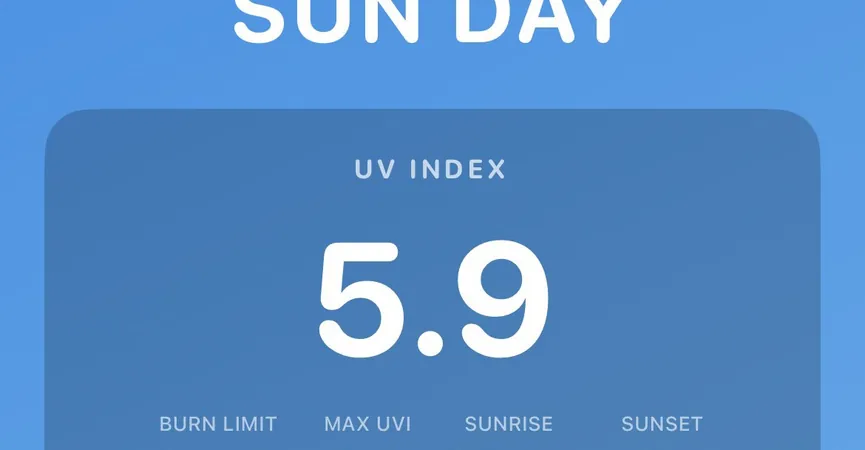
Double Trouble for Mangroves: Rising Seas and Intensifying Storms Spell Disaster
2025-06-09
Author: Charlotte
A startling new study reveals that over half of the world's mangrove regions could face "severe and widespread risk" from climate change by the year 2100. This alarming prediction is driven by two main threats: intensifying tropical cyclones and rising sea levels.
The research, utilizing a groundbreaking open-source risk index, predicts these risks across different greenhouse gas emissions scenarios set by the Intergovernmental Panel on Climate Change (IPCC). Sarah Hülsen, the lead researcher from ETH Zürich, underscores that virtually every region will witness an uptick in risk.
Southeast Asia is poised to bear the brunt of these changes, with projected increases in cyclone frequency and intensity. The study highlights that even under the best-case emissions scenario, regions like Central America, Southeast Africa, and East Asia will experience heightened tropical cyclone impacts.
In the eastern Philippines alone, researchers anticipate a shocking 254% increase in tropical cyclones compared to historical records, leading to storms that could occur four times more frequently than expected.
The Ripple Effects of Mangrove Loss
The stakes are high. The destruction of mangroves isn't just an environmental issue; it threatens significant economic and human livelihoods. Globally, mangroves provide flood protection worth over $65 billion annually, with around 775 million individuals relying heavily on these vital coastal ecosystems.
Mangroves serve as natural buffers against erosion, enrich biodiversity, capture carbon, and support fisheries. Yet, the regions that depend most on these ecosystems are among those facing the greatest dangers.
Urgent Action Required
According to the study, up to 98% of Southeast Asia's mangroves—and 97% that protect critical assets—will be at high or severe risk under a high emissions scenario. With a pressing need for effective conservation strategies, Hülsen emphasizes that planners require detailed insights to direct their efforts effectively.
Crucially, decisive actions to curb greenhouse gas emissions should be at the forefront of the agenda. The analysis shows that if emissions are kept moderate, only 1% of mangroves will face the highest risk, whereas a scenario of very high emissions could see that figure rise to 20%.
A New Tool for Understanding Risks
The innovative risk index created by Hülsen's team uniquely combines two major threats facing mangroves—climate-driven storms and sea level rise—making it a pioneering tool for risk assessment across global ecosystems. "Integrating complex climate projections with real-world data is a monumental achievement," comments Temilola Fatoyinbo, a NASA scientist.
Adapting to Future Challenges
Despite their resilience, mangroves face unprecedented challenges as storm frequencies increase and sea levels rise. While they can potentially grow upward to adapt to small increases in sea level, research indicates that exceeding a rise of 7 mm per year could lead to widespread die-offs.
The growing intensity of cyclones means mangroves may not have time to recover between storms, leading to long-term structural changes. Restoration efforts take decades, and ongoing challenges such as sea level rise make recovery immensely difficult.
Inland Migration: A Possible Solution?
As sea levels rise, one potential strategy is to facilitate the inland migration of mangroves, a tactic currently under trial in Indonesia's Java province. Here, efforts are underway to reverse shrimp farm conversions to restore mangrove habitats while offering sustainable farming alternatives.
Despite ongoing uncertainties about these pilot projects, Hülsen advocates for restoring degraded areas, combating pollution, and closely monitoring high-risk zones to maximize mangroves' resilience.
A Call for Long-Term Action
No single approach can solve the impending crisis facing mangroves. Hülsen emphasizes that every degree of warming we prevent—and each piece of intact nature we save—matters immensely for the future of coastal communities and ecosystems. The time to act is now.









 Brasil (PT)
Brasil (PT)
 Canada (EN)
Canada (EN)
 Chile (ES)
Chile (ES)
 Česko (CS)
Česko (CS)
 대한민국 (KO)
대한민국 (KO)
 España (ES)
España (ES)
 France (FR)
France (FR)
 Hong Kong (EN)
Hong Kong (EN)
 Italia (IT)
Italia (IT)
 日本 (JA)
日本 (JA)
 Magyarország (HU)
Magyarország (HU)
 Norge (NO)
Norge (NO)
 Polska (PL)
Polska (PL)
 Schweiz (DE)
Schweiz (DE)
 Singapore (EN)
Singapore (EN)
 Sverige (SV)
Sverige (SV)
 Suomi (FI)
Suomi (FI)
 Türkiye (TR)
Türkiye (TR)
 الإمارات العربية المتحدة (AR)
الإمارات العربية المتحدة (AR)